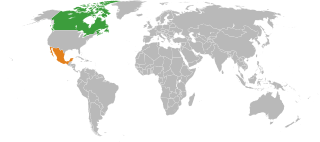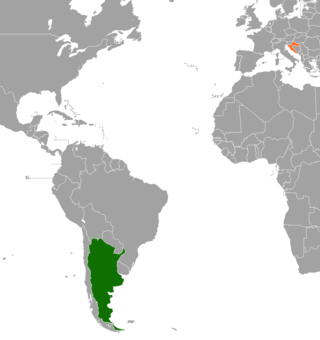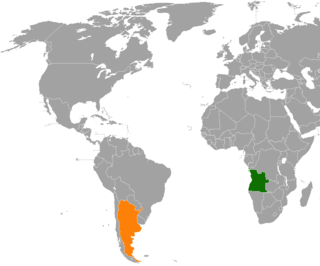
The nations of Canada and Mexico established formal diplomatic relations in 1944. Initially, ties between the two nations were dormant, but since the 1990s relations between Canada and Mexico have positively developed as both countries brokered NAFTA.

Bilateral relations between the Argentine Republic and Canada have existed for over a century. Both nations are members of the Cairns Group, G20, Organization of American States and the United Nations.

The current and historical relations between the Argentine Republic and the Republic of South Africa, for over a century. Both nations are members of the Cairns Group, G20, Group of 77 and the United Nations.

Diplomatic relations between the Argentine Republic and Ukraine have existed for decades. The importance of relations centers on the history of Ukrainian migration to Argentina. Ukrainians in Argentina form the second largest Ukrainian community in Latin America numbering approximately 250,000 Ukrainians and their descendants.

Argentina and Croatia both enjoy friendly relations, the importance of which centers on the history of Croatian migration to Argentina. There is approximately a community of 250,000 Argentines of Croatian descent. Both nations are members of the United Nations.

The Armenian community in Argentina is the largest in Latin America totaling approximately 120,000 members.

Current and historical relations between the Argentine Republic and the Russian Federation have existed for decades. Both nations are members of the G20 and the United Nations.

The nations of Chile and Mexico established diplomatic relations in 1831, however, relations were severed in 1974 in the aftermath of the 1973 Chilean coup d'état. Diplomatic relations were re-established in 1990 and have continued unabated since.

The nations of Brazil and Mexico established diplomatic relations in 1825. Together, Brazil and Mexico account as the most populous nations in Latin America and both nations have the largest global emerging economies and are considered to be regional powers. Both countries are members of the Community of Latin American and Caribbean States, G-20 major economies, Latin American Integration Association, Organization of American States, Organization of Ibero-American States and the United Nations.

The nations of Mexico and Uruguay established diplomatic relations in 1831. Both nations are members of the Latin American Integration Association, Organization of American States, Organization of Ibero-American States and the United Nations.

The nations of Mexico and Paraguay established diplomatic relations in 1831. Both countries are full members of the Community of Latin American and Caribbean States, Latin American Integration Association, Organization of American States, Organization of Ibero-American States and the United Nations.

The People's Democratic Republic of Algeria and the Argentine Republic are members of the Group of 15, Group of 24, Group of 77 and the United Nations.

Diplomatic relations between the Argentine Republic and the Republic of El Salvador have existed for over a century. Both nations are members of the Community of Latin American and Caribbean States, Group of 77, Organization of American States, Organization of Ibero-American States and the United Nations.

The Republic of Angola and the Argentine Republic are members of the Group of 77 and the United Nations.

Mexico–Philippines relations are the bilateral relations of the United Mexican States and the Republic of the Philippines. Mexico and the Philippines share a common history dating from when the Viceroyalty of New Spain ruled the Spanish East Indies for the Spanish Crown. Both nations are members of the Asia-Pacific Economic Cooperation, and the United Nations.

Diplomatic relations between the Argentine Republic and the Republic of the Philippines, have existed for decades. Both nations are members of the Association of Academies of the Spanish Language, Group of 77, the G20 developing nations, and Forum of East Asia-Latin America Cooperation and the United Nations.

The nations of Mexico and Peru established diplomatic relations in 1823. Diplomatic relations were briefly cut in 1932 and reinstated again in 1933. Both nations are members of the Asia-Pacific Economic Cooperation, Community of Latin American and Caribbean States, Lima Group, Organization of Ibero-American States, Organization of American States, Pacific Alliance and the United Nations.

The nations of Costa Rica and Mexico established diplomatic relations 1838. Both nations are members of the Association of Caribbean States, Community of Latin American and Caribbean States, Organization of American States, Organization of Ibero-American States and the United Nations.

Mexico–Saudi Arabia relations are the diplomatic relations between Mexico and Saudi Arabia. Both nations are mutual members of the G-20 major economies and the United Nations.

Mexico–Vietnam relations are the diplomatic relations between Mexico and Vietnam. Both nations are members of the Asia-Pacific Economic Cooperation, Forum of East Asia-Latin America Cooperation and the United Nations.































